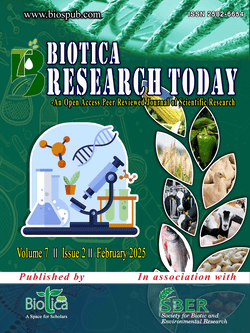
Selective Genotyping: A Rapid and Cost-Effective Approach for QTL Detection
Bidwan Rath*
Division of Genetics, ICAR-Indian Agricultural Research Institute (IARI), New Delhi (110 012), India
Kavya M.E.
Dept. of Genetics and Plant Breeding, University of Agricultural Sciences (UAS), Bangalore, Karnataka (560 065), India
Prashantha V.
Dept. of Genetics and Plant Breeding, University of Agricultural Sciences (UAS), Bangalore, Karnataka (560 065), India
Shirisha K.M.
Dept. of Genetics and Plant Breeding, University of Agricultural Sciences (UAS), Bangalore, Karnataka (560 065), India
Kemparaju M.
Dept. of Genetics and Plant Breeding, University of Agricultural Sciences (UAS), Bangalore, Karnataka (560 065), India
DOI: NIL
Keywords: BSA, Genetic hitchhiking, Marker-assisted breeding, QTL
Abstract
Detection and mapping of QTLs through the genotyping of an entire mapping population is a time and cost demanding avenue. Genotyping the individuals exhibiting extreme phenotypes in the mapping population for QTL discovery is a cost-effective and rapid alternative. Selective genotyping is one such approach that identifies markers linked to QTLs based on a comparison between marker allele frequencies of individuals showing extreme phenotypes in the mapping population. When the cost of genotyping exceeds that of phenotyping, selective genotyping becomes more cost-effective over conventional QTL mapping. Selective genotyping also offers breeders the opportunity for simultaneous breeding and QTL detection in the segregating generation. Nevertheless, the efficiency of selective genotyping is influenced by various factors that must be optimized prior to its implementation for marker-trait linkage identification.
Downloads
not found
Reference
Gallais, A., Moreau, L., Charcosset, A., 2007. Detection of marker-QTL associations by studying change in marker frequencies with selection. Theoretical and Applied Genetics 114, 669-681. DOI: https://doi.org/10.1007/s00122-006-0467-z.
Navabi, A., Mather, D.E., Bernier, J., Spaner, D.M., Atlin, G.N., 2009. QTL detection with bidirectional and unidirectional selective genotyping: Marker-based and trait-based analyses. Theoretical and Applied Genetics 118, 347-358. DOI: https://doi.org/10.1007/s00122-008-0904-2.
Sun, Y., Wang, J., Crouch, J.H., Xu, Y., 2010. Efficiency of selective genotyping for genetic analysis of complex traits and potential applications in crop improvement. Molecular Breeding 26, 493-511. DOI: https://doi.org/10.1007/s11032-010-9390-8.
Yang, L., Zhao, D., Meng, Z., Xu, K., Yan, J., Xia, X., Zhang, Y., 2020. QTL mapping for grain yield-related traits in bread wheat via SNP-based selective genotyping. Theoretical and Applied Genetics 133, 857-872. DOI: https://doi.org/10.1007/s00122-019-03511-0.
